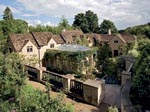Eco towns shortlisted
The shortlist of the fifteen proposed eco-town sites has been published by the Government, ten of which will be built to ease housing demand


Fifteen locations for potential new eco-towns have been announced by the Government today. Eco towns have been conceived as new locations for communities in areas where new, affordable housing is required and will be extremely environmentally friendly - all the towns are to be zero carbon. They are to be built only on reclaimed or Brownfield sites; the Government has pledged not to build on any Greenfield sites for these new conurbations. The shortlist will now be examined by an expert panel, and the chosen towns will be named later this year. Five of the towns will be built 2016 and all ten by 2020 as part of a drive to build 3 million new homes by 2020. Most of the new eco towns will be built near to existing conurbations, some closer than others, and many of the shortlist are to be built on old airfields or RAF bases. Housing Minister Caroline Flint said: We have a major shortfall of housing and with so many buyers struggling to find suitable homes, more affordable housing is a huge priority. To face up to the threat of climate change, we must also cut the carbon emissions from our housing. Eco-towns will help solve both of these challenges. Building in existing towns and cities alone simply cannot provide enough new homes. I understand this is an issue that can raise strong opinions, but everyone now has the opportunity to express their views before any decisions are made because this is an issue that affects us all. However some have questioned the wisdom of creating towns from scratch. James Rowlands, RICS public policy officer said: The development of brand new towns runs the risk of creating isolated pockets of housing that are not effectively linked into existing communities. Potential environmental benefits from eco-towns would be lost if strong communities are not created or if the people who live in them are reliant on private cars for transport. It may be better to look at the possibility of creating eco-extensions to existing communities, rather than completely new towns. A spokesperson for the Government has said that the towns will all be built in areas where demand for housing is either high or extremely high, and this should ensure the populations of these towns are maintained, and that transport links to other towns and cities will all be put in place to ensure people are not reliant on private cars, but the plans are all still at an early stage. For more information, visit www.communities.gov.uk Eco-towns shortlist * Pennbury, Leicestershire: 12-15,000 homes on a development incorporating brownfield, greenfield and surplus public sector land. Four miles south east of Leicester. This proposal could include 4,000 new affordable houses in an area of high affordability pressure. * Manby and Strubby, Lincolnshire: 5,000 homes put forward by East Lindsey District Council on two sites, with large elements of brownfield land including a former RAF base. The proposal complements the strategic plan for the phased relocation of communities on Lincolnshire coast because of high flood risk, and could include 1,500 affordable homes in an area of very high affordability pressure. * Curborough, Staffordshire: 5,000 homes on the brownfield site of the former Fradley airfield, ten miles from Burton. The proposal could include 2,000 affordable houses in an area of very high affordability pressure. * Middle Quinton, Warwickshire: 6,000 homes on a former Royal Engineers depot which has a rail link to the Worcester-London rail line. Six miles South West of Stratford upon Avon. The proposal could include 2,000 affordable houses in an area of very high affordability pressure. * Bordon-Whitehill, Hampshire: 5-8,000 homes on a site owned by the Ministry of Defence. A significant number of ex-MoD homes are already on the site, west of Whitehill-Bordon. The proposal could include 2,000 affordable houses in an area of very high affordability pressure. * Weston Otmoor, Oxfordshire: 10-15,000 homes on a site adjoining the M40 and the Oxford-Bicester railway. Three miles south west of Bicester, the site includes a current airstrip. The scheme could include between 3,000 and 5,000 affordable homes, in an area of extreme affordability pressure. * Ford, West Sussex: 5,000 homes on a site which includes brownfield land and the former Ford airfield. Close to rail line linking London and the Sussex coast. The scheme could include 1,500 affordable homes, in an area of very high affordability pressure. * Imerys China Clay Community, Cornwall: Development of around 5,000 homes on former china clay workings, industrial land and disused mining pits no longer needed by owner Imerys. Close to St Austell. The scheme could include 1,500 affordable homes, in an area of extreme affordability pressure. * Rossington, South Yorkshire: Up to 15,000 homes regenerating the former colliery village of Rossington, three miles south of Doncaster. The scheme could include 1,500 affordable homes, in an area of moderate affordability pressure. * Coltishall, Norfolk: 5,000 homes on a former RAF airfield, eight miles north of Norwich. The scheme could include 2,000 affordable homes in an area of very high affordability pressure. * Hanley Grange, Cambridgeshire: 8,000 homes on land adjacent to the A11 designed to improve the severe lack of housing in and around Cambridge. The scheme could include 3,000 affordable homes in an area of extreme affordability pressure. * Marston Vale and New Marston, Bedfordshire: Up to 15,400 homes on a series of sites, including former industrial sites, along the east-west rail line to Stewartby and Millbrook. The scheme could include 2,000 affordable homes in an area of high affordability pressure. * Elsenham, Essex: A minimum of 5,000 homes north east of the existing Elsenham village. Close to M11 and the London to Cambridge rail line. The scheme could include 1,800 affordable homes in an area of extreme affordability pressure. * Rushcliffe, Nottinghamshire: An eco-town proposal was submitted for Kingston-on-Soar, to the south of Nottingham. In response to representations from Rushcliffe Borough Council, this site is not to be pursued. However, the Government is proposing to carry out a further review in partnership with RBC to consider whether there is a suitable alternative location with the potential to be viable within the Rushcliffe local authority area. * Leeds City Region, Yorkshire: A number of eco-town proposals were submitted for locations within the area of Leeds City Region partnership of 11 authorities and principally between Leeds and Selby. The Leeds City Region Partnership has indicated support in principle for an eco-town within the sub-region.
Sign up for the Country Life Newsletter
Exquisite houses, the beauty of Nature, and how to get the most from your life, straight to your inbox.
-
 ‘It had the air of an ex-rental, and that’s putting it politely’: How an antique dealer transformed a run-down Georgian house in Chatham Dockyards
‘It had the air of an ex-rental, and that’s putting it politely’: How an antique dealer transformed a run-down Georgian house in Chatham DockyardsAn antique dealer with an eye for colour has rescued an 18th-century house from years of neglect with the help of the team at Mylands.
By Arabella Youens
-
 A home cinema, tasteful interiors and 65 acres of private parkland hidden in an unassuming lodge in Kent
A home cinema, tasteful interiors and 65 acres of private parkland hidden in an unassuming lodge in KentNorth Lodge near Tonbridge may seem relatively simple, but there is a lot more than what meets the eye.
By James Fisher